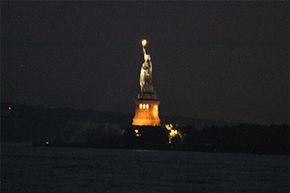What Causes Blackouts?
Just after 4 p.m. on Aug. 14, 2003, a huge swath of the eastern U.S. and Canada went dark. The massive 2003 blackout affected 50 million people across eight U.S. states and the Canadian province of Ontario. Power in some areas wasn't restored for two days [source: USCPSOTF].
Although blackouts of this magnitude are rare, they draw attention to weaknesses in the power grid system. The U.S.-Canadian power grid is actually composed of three separate grids: the Eastern Interconnection, the Western Interconnection, and the ERCOT Interconnection (also known as the Texas Interconnection). Within each of these three grids, hundreds of power plants must produce electricity to keep up with constantly shifting power demands across the grid.
Advertisement
If one power plant goes down, or one high-voltage transmission line is cut, or one generator fails, then other units must pick up the slack. Usually this isn't a problem. But when demand for electricity is high — as it was on that hot August afternoon in 2003 — isolated failures in the grid can trigger a cascade of breakdowns leading to millions of people going without power.
The cause of the 2003 blackout was a combination of human error, computer malfunctions and overgrown trees near power lines. It started with a few generators going offline in Northern Ohio because of mechanical trouble. The load was shifted to nearby generators, but overgrown trees made contact with overhead power lines, causing those lines to trip. Utility companies in the region didn't have adequate monitoring systems in place, so workers failed recognize the severity of the situation before generators across the region became overloaded and shut down [source: USCPSOTF].
Like a circuit breaker, components of a power grid can "trip" and shut off when a load is dangerously high. The result is that the load is passed on to other parts of the grid network, which may also shut down, creating a domino effect that leads to a blackout.
While human error and computer malfunctions can be remedied, there's not much utility companies can do about bad weather. Severe weather — high winds, lightning strikes, heavy snowfall — is the No. 1 cause of power outages in America [source: DOE].
The next time you drive down the road and look at the power lines, or the next time you flip on a light, you'll hopefully have a much better understanding of what is going on. The power distribution grid is truly an incredible system.
Related Articles
More Great Links
Sources
- Current Results. "Average Annual Sunshine by State" (May 22, 2015) http://www.currentresults.com/Weather/US/average-annual-state-sunshine.php
- Tesla Motors. "Powerwall" (May 22, 2015) http://www.teslamotors.com/powerwall
- Union of Concerned Scientists USA. "How the Electricity Grid Works." Feb. 18, 2015 (May 22, 2015) http://www.ucsusa.org/clean-energy/how-electricity-grid-works#.VVuR7JNVikp
- U.S. Department of Energy (DOE). "Grid-Connected Renewable Energy Systems." Jan. 28, 2015 (May 22, 2015) http://energy.gov/energysaver/articles/grid-connected-renewable-energy-systems
- U.S. Department of Energy (DOE). "Renewable Energy" (May 22, 2015) https://www.smartgrid.gov/the_smart_grid/renewable_energy
- U.S. Department of Energy (DOE). "Top 9 Things You Didn't Know About America's Power Grid." Nov. 20, 2014 (May 22, 2015) http://energy.gov/articles/top-9-things-you-didnt-know-about-americas-power-grid
- U.S. Department of Energy. "What is the Smart Grid?" (May 22, 2015) https://www.smartgrid.gov/the_smart_grid/smart_grid
- U.S. Energy Information Administration (EIA). "Energy in Brief." Sept. 16, 2014 (May 22, 2015) http://www.eia.gov/energy_in_brief/article/power_grid.cfm
- U.S. Energy Information Administration. "What is U.S. electricity generation by source?" March 31, 2015. (June 1, 2015). http://www.eia.gov/tools/faqs/faq.cfm?id=427&t=3
- U.S. Environmental Protection Agency (EPA). "Sources of Greenhouse Gas Emissions" (May 22, 2015) http://www.epa.gov/climatechange/ghgemissions/sources.html
- U.S.-Canada Power System Outage Task Force. "Interim Report: Causes of the August 14th Blackout in the United States and Canada." November 2003 (May 22, 2015) http://emp.lbl.gov/sites/all/files/interim-rpt-Aug-14-blkout-03.pdf
